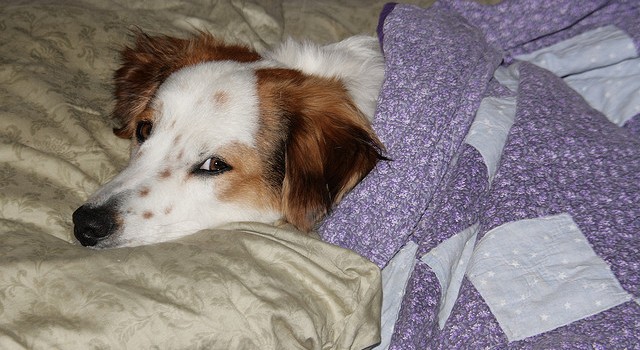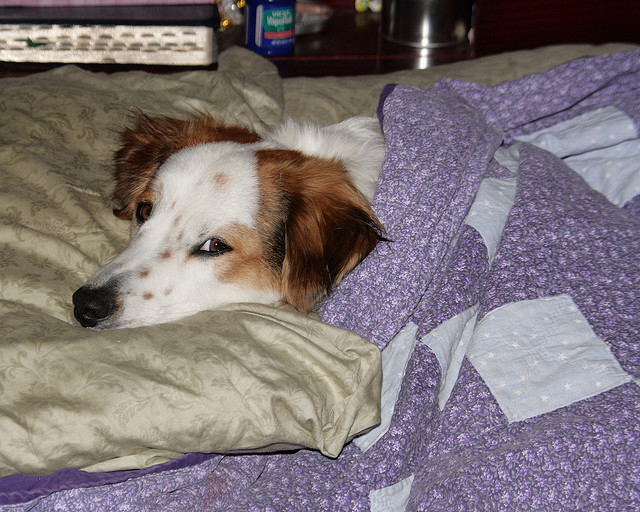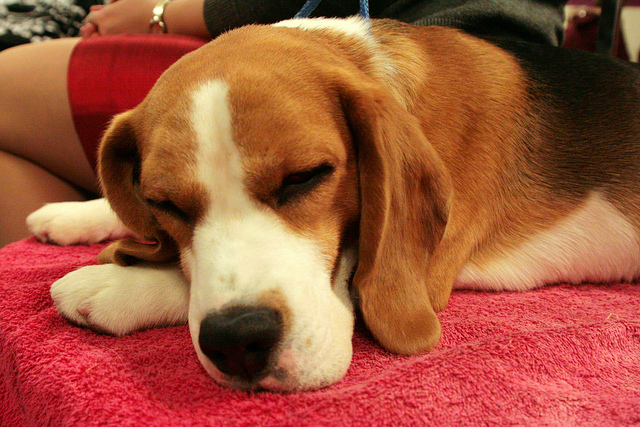Some professionals say that pets should not sleep in bed with their humans. These reasons vary from it affecting the quality of sleep and continue on all the way down to the cleanliness of it. Some even tend to think of it more as a dominance type of thing, like the dog knows he’s the boss because he sleeps in your bed every night.
Yeah, I kind of think that last one is silly too. We all know dogs just want in the bed because we are there and it is comfortable and warm.
It really comes down to a personal choice and varies from person to person. Some people don’t let their dogs inside their bedrooms at all so their is no dander or distractions when felling asleep. Some dogs can handle this while others will have to adjust. Other dogs have deeper issues and fall into a large category of bed guarding.
See why some dogs are like this, why they tend to act in certain ways when it comes to the bed and how to start dealing with it:
Modifying your dog’s aggressive behavior is not a bad idea; there’s a good chance that the dog who guards the bed may also guard the sofa and other prime pieces of household real estate. Help him become more comfortable with humans, and work to reduce or eliminate his perceived need to behave in an aggressive manner. This will help keep you and any other humans he comes in contact with safe, and increases the odds that he’ll stay in your home -and that your relationship with your significant other will last!
When we adopted our Pomeranian bed-buddy, Scooter, he brought along a lot of behavioral baggage. He had failed his shelter assessment when he fiercely guarded a pig ear, so we knew about that one. We would quickly discover several more challenging behaviors. One of Scooter’s early behavior challenges was stress-licking. Our new pint-sized pooch woke me up in the middle of the night, constantly licking his front paws. Sleepily, I reached down to gently push his face away from his feet and BAM! In an instant he snarled ferociously and bit my hand three times in rapid succession. There was no blood. In fact, I never even felt the pressure of his teeth on my skin. Despite his ferocious threat display, the little guy had admirable bite inhibition. He didn’t want to hurt me, he just wanted me not to push on him. So I obliged; I’m a fast learner! And yes, he stayed on the bed. Over the months since we adopted him almost a year ago we’ve worked to get him more comfortable with being touched, nudged, and picked up, using counter-conditioning to give him a positive association with those interactions. And we use management. If we need to move him from one spot to another or interrupt his licking (which has greatly decreased as his stress has diminished), rather than push, we simply lift the covers to slide him to a new spot.
If you are experiencing bed-related aggression, take the time to analyze what’s going on. If it’s a non-guarding behavior that can be managed, you can manage and live with it, or manage and modify. If it’s guarding, or some other aggression trigger that’s not easily managed, then “off the bed” is a wise step, at least until the behavior can be modified.
Revoking bed privileges: Get him accustomed to his soon-to-be new sleeping location as a daytime game, by using treats, stuffed Kongs, and other delectables to convince him that wonderful things happen in the designated area. Meanwhile, add a blanket to your own bed for him to sleep on while awaiting the transition to his new quarters. When you’re ready to make the move, transfer his blanket to his new sleeping spot as well, so he has the familiar sleeping association in his bedroom. When he’s happy to hop into his new quarters and stay in for an hour or more without a fuss during the day, start sending him there at bedtime. The first time you do, be sure he’s had a very full day with lots of exercise, so he’s ready for a good night’s sleep.
Modifying bed-or owner-guarding: So you have a dog who guards the bed, or guards you on the bed. What next? You don’t necessarily have to prohibit him from ever getting on the bed (or other furniture), but you do need a way to peacefully remove him from furniture when you need him to get off. And ultimately you’d like him to peacefully accept people approaching the bed.
• Teach “off” -To start, you can teach an operant cue to ask the dog to happily hop off the bed when asked. This is pretty simple. Say “Up!” to invite him on the bed. Lure him up if necessary. When he’s up, click and treat. Then say “Off!” and toss a tasty treat on the floor. When he jumps off to get it, click; he’ll get the treat off the floor himself, thank you very much. After several repetitions of this, start fading the lure, by giving the “Up” or “Off” cue and then waiting a few seconds to see if he does the requested behavior.
• Institute a “say please” program – “Say please” simply means teaching your dog to “ask” for all good things by sitting first. “Sit” is a deference behavior, and when your dog learns to sit for good stuff, he learns to be more deferent. “Want a cookie?” Sit first. “Want to go outside?” Sit first. “Want your dinner bowl?” Sit first. “Want me to throw the ball?” Sit first. You get the idea.
Meanwhile, what do you do when your dog, ensconced on your bed, growls at you or your bed partner? Calmly stop, stand still, wait until he relaxes a little, and then stop doing whatever it was that elicited the growl. If you were touching him, stop touching him, and make a mental note to start counter-conditioning him to love being touched. If you were approaching the bed, invite him off with his “Off!” cue to defuse the current situation, and then start putting together a management and behavior modification plan.
There’s absolutely nothing to be gained by aggressing back at your dog with verbal or physical punishment when he growls at you. That’s so important I’ll say it again: Do not punish your dog for growling. Punishment is likely to make his behavior worse, because your aggression will add to his stress. It’s your job, as the one with the bigger brain, to figure out how to remove the stress from the situation for him.
Article Source: The Whole Dog Journal
Image Source: Michael Quick on Flickr





Leave a Reply